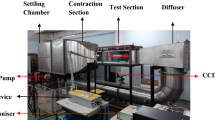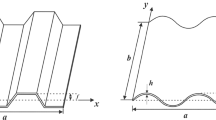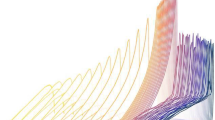Abstract
This study aims to isolate and evaluate the influence of a corrugation on flow structures and aerodynamics under compressible low Reynolds number conditions, and to compare it to simpler but well-known model: the flat plate. The simplified corrugated model was made by a flat surface with only two corrugations on the leading edge. The models only differ for the corrugations on the leading edge. Force values were measured at a Reynolds number ranging from 10,000 to 25,000 and at a Mach number from 0.2 to 0.6. Pressure sensitive paint was used at the same flow conditions and the pressure distribution over the models was obtained. Schlieren visualization was also conducted and flow characteristics were observed. Detailed analysis showed that the corrugated model experiences strong depression on the leading edge caused by the separation of the boundary layer. Because of the presence of the corrugation, the shear layer transitions to turbulent rapidly and reattaches to the surface before reaching the summit of the first corrugation, separating again at its peak. Instabilities in the shear layer were dissipated thanks to the shape of the corrugation allowing pressure recovery and discouraging flow separation. The flow reattaches before reaching the trailing edge. The results showed that the transition of the boundary layer was accelerated as the Reynolds number increases on corrugated model, leading to a stronger negative pressure zone in the leading edge. Due to pressure recovery being less effective, lead to similar performances for the range of studied Reynolds numbers. The compressibility effects resulted in a delay on the transition of the instability of the shear layer, negatively affecting the intensity of the pressure gradients as well as pressure recovery. This contributed to the variation in the performance of the wing. As a result, the corrugated model has a better aerodynamic performance compared to the flat plate at low Reynolds numbers, but not for higher Mach numbers.
Graphic abstract





























Similar content being viewed by others
References
Anyoji M, Nose K, Ida S, Numata D, Nagai H, Asai K (2011) Development of a low-density wind tunnel for simulating Martian atmospheric flight. Trans Jpn Soc Aeronaut Space Sci Aerosp Technol Jpn 9:21–27
Anyoji M, Numata D, Nagai H, Asai K (2015) Effects of Mach number and specific heat ratio on low-Reynolds-number airfoil flows. AIAA J 53(6):1640–1654
Anyoji M (2011) Development of a mars wind tunnel and its applications to low Reynolds number and high-subsonic airfoil testing. Ph.D. thesis
Canuto D, Taira K (2015) Two-dimensional compressible viscous flow around a circular cylinder. J Fluid Mech 785:349–371
Feng H, Zhou Z, Zhou B-R, Bai Y (2011) Structure of the budding yeast saccharomyces cerevisiae centromeric histones cse4-h4 complexed with the chaperone scm3. Proc Natl Acad Sci 108(35):E596–E596
International Space Exploration Coordination Group (ISEG) (2018) The global exploration roadmap. https://www.globalspaceexploration.org/
Kawachi K (1999) Flight mechanism of insect (from standpoint of view of bio-fluid-dynamics). Biophysics 39(5):279–284 ((in Japanese))
Kuchiishi S, Kurita M, Mitsuo K, Fujii K (2008) Development of a self-illumination correction program for pressure-sensitive paint measurements. Technical report JAXA-RR-08-002, Japan Aerospace Exploration Agency (in Japanese)
Kunz PJ (2003) Aerodynamics and design for ultra-low Reynolds number flight. Princeton, Citeseer
Kusama K, Nagata T, Anyoji M, Nonomura T, Asai K (2012) Investigation of Mach number effects on flow over a flat plate at Reynolds number of \(1.0\times 10^4\) by Schlieren visualization. Fluid Dyn Res 53:015513
Liu T (2011) Pressure- and temperature-sensitive paints. In: Blockley R, Shyy W (eds) Encyclopedia of aerospace engineering. https://doi.org/10.1002/9780470686652.eae076
Mangeol E, Ishiwaki D, Wallisky N, Asai K, Nonomura T (2017) Compressibility effects on flat-plates with serrated leading-edges at a low Reynolds number. Exp Fluids 58(11):159
Mori H, Niimi T, Oshima Y, Hirako M (2004) Development of pressure sensitive paint suitable to surface pressure measurement in high-Knudsen number flows. Nihon Kikai Gakkai Ronbunshu, B Hen/Trans Jpn Soc Mech Eng B 70(699):2721–2728
Morizawa S, Nonomura T, Oyama A, Fujii K, Obayashi S (2018) Effect of Mach number on airfoil characteristics at Reynolds number of 3000. Trans Jpn Soc Aeronaut Space Sci 61(6):258–267
Murphy JT, Hu H (2010) An experimental study of a bio-inspired corrugated airfoil for micro air vehicle applications. Exp Fluids 49(2):531–546
Nagata T, Noguchi A, Kusama K, Nonomura T, Atsushi Komuro A, Asai K (2020) Experimental investigation on compressible flow over a circular cylinder at Reynolds number of between 1000 and 5000. J Fluid Mech 893:A13
Nagata T, Noguchi A, Nonomura T, Ohtani K, Asai K (2020) Experimental investigation of transonic and supersonic flow over a sphere for Reynolds numbers of 10 3–10 5 by free-flight tests with schlieren visualization. Shock Waves 30(2):139–151
Nagata T, Nonomura T, Takahashi S, Fukuda K (2020) Direct numerical simulation of subsonic, transonic and supersonic flow over an isolated sphere up to a Reynolds number of 1000. J Fluid Mech 904:A36
Nagata T, Nonomura T, Takahashi S, Mizuno Y, Fukuda K (2016) Investigation on subsonic to supersonic flow around a sphere at low Reynolds number of between 50 and 300 by direct numerical simulation. Phys Fluids 28(5):056101
Obata A, Sinohara S (2009) Flow visualization study of the aerodynamics of modeled dragonfly wings. AIAA J 47(12):3043–3046
Okamoto M, Yasuda K, Azuma A (1996) Aerodynamic characteristics of the wings and body of a dragonfly. J Exp Biol 199(2):281–294
Rees CJC (1975) Form and function in corrugated insect wings. Nature 256(5514):200
Ruyten WM (1997) Self-illumination calibration technique for luminescent paint measurements. Rev Sci Instrum 68(9):3452–3457
Sansica A, Ohmichi Y, Robinet J-C, Hashimoto A (2020) Laminar supersonic sphere wake unstable bifurcations. Phys Fluids 32(12):126107
Sansica A, Robinet JC, Alizard F, Goncalves E (2018) Three-dimensional instability of a ow past a sphere: Mach evolution of the regular and Hopf bifurcations. J Fluid Mech 855:1088–1115
Sant YL (2001) Overview of the self-illumination effect applied to pressure sensitive paint applications. In: ICIASF 2001 record, 19th international congress on instrumentation in aerospace simulation facilities (Cat. No. 01CH37215). IEEE, pp 159–170
Savage SB, Newman BG, Schouella D (1977) Model test on a wing section of a dragonfly. In: Scale effects in animal locomotion, pp 445–477
Seifert A, Levy D (2009) Simplified dragonfly airfoil aerodynamics at Reynolds numbers below 8000. Phys Fluids 21(7):071901
Seifert A, Levy D (2010) Parameter study of simplified dragonfly airfoil geometry at Reynolds number of 6000. J Theor Biol 266:691–702
Settles GS (2012) Schlieren and shadowgraph techniques: visualizing phenomena in transparent media. Springer, Berlin
Tamai M, Wang Z, Rajagopalan G, Hu H, He G (2007) Aerodynamic performance of a corrugated dragonfly airfoil compared with smooth airfoils at low reynolds numbers. In: 45th AIAA aerospace sciences meeting and exhibit, p 483
Tsuzuki N (2005) A study on a miniature rotary-wing vehicle for mars exploration: its feasibility and aerodynamic characteristics of the rotor. Ph.D. thesis, University of Tokyo
Vargas A, Mittal R, Dong H (2008) A computational study of the aerodynamic performance of a dragonfly wing section in gliding flight. Bioinspir Biomim 3(2):026004
Visba MR, Barnes CJ (2013) Numerical exploration of the origin of aerodynamic enhancements in [low-reynolds number] corrugated airfoils. Phys Fluids 25(11):483
Wakeling JM, Ellington CP (1997) Dragonfly flight. I. Gliding flight and steady-state aerodynamic forces. J Exp Biol 200(3):543–556
Williford KH, Farley KA, Stack KM, Allwood AC, Beaty D, Beegle LW, Bhartia R, Brown AJ, de la Torre Juarez M, Hamran S-E, et al (2018) The nasa mars 2020 rover mission and the search for extraterrestrial life. In: From habitability to life on mars. Elsevier, pp 275–308
Acknowledgements
This work has been carried out in the framework of the exchange agreement between ISAE-SUPAERO and Tohoku University. The present work was supported by the Japan Society for the Promotion of Science, KAKENHI Grants 18K18906.
Author information
Authors and Affiliations
Corresponding author
Ethics declarations
Conflict of interest
The authors declare that they have no conflict of interest.
Additional information
Publisher's Note
Springer Nature remains neutral with regard to jurisdictional claims in published maps and institutional affiliations.
Appendix 1: Influence of self-illumination on PSP measurements
Appendix 1: Influence of self-illumination on PSP measurements
The PSP results of the corrugated model are considered to be influenced by the self-illumination due to its shape of the model, which has concave-shaped sections. In the case of the concave-shaped object, the PSP emission from a certain point captured by the camera includes the reflected component of the emission from the other point as shown in below (Kuchiishi et al. 2008):
where \(L_i\), \(L_j\), and \(L_{0,i}\) are measured intensity at the point i (point of interest), the measured intensity at the point j (the other point on the model), and actual intensity at the point of interest, respectively. Also, R and \(F_{ij}\) are the reflectance at the point of interest and the form factor between the point of interest and the other point j, respectively. Therefore, reflection correction can be conducted as follows:
The reflectance of the PSP R used in the present study was measured by the method proposed by Ruyten (1997), and the value was \(R=0.6\). The overview of the influence of the self-illumination and its correction method is described by Le Sant (2001). Figure 29a shows the influence of the self-illumination on the \(C_p\) distribution at \(M=0.6\) of Re \(=1.0\times 10^4\). The highest M condition, which is considered to have the greatest influence of the self-illumination, were selected to provide the influence of the self-illumination in worst case. It can be seen that the \(C_p\) distributions before and after applying the reflection correction are different, but the difference is sufficiently small. The \(C_p\) profile is slightly changed by reflection correction at the valleys of both corrugations of the model, while the rest of the chord remains mostly unmodified. Hence, the influence of the self-illumination on the \(C_p\) distribution obtained by the PSP measurements is small. Figure 29b shows the difference between the \(C_p\) before and after applying the reflection correction. The difference in the \(C_p\) is less than 0.05. It is sufficiently smaller compared with the variation of \(C_p\) in the chord direction.
Rights and permissions
About this article
Cite this article
Guilarte Herrero, A., Noguchi, A., Kusama, K. et al. Effects of compressibility and Reynolds number on the aerodynamics of a simplified corrugated airfoil. Exp Fluids 62, 63 (2021). https://doi.org/10.1007/s00348-021-03164-0
Received:
Revised:
Accepted:
Published:
DOI: https://doi.org/10.1007/s00348-021-03164-0





